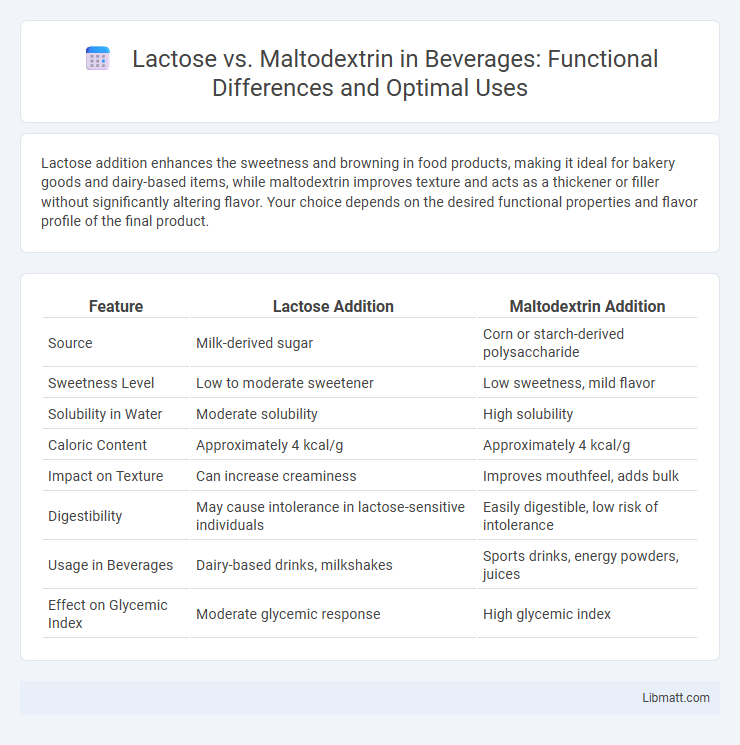Lactose addition enhances the sweetness and browning in food products, making it ideal for bakery goods and dairy-based items, while maltodextrin improves texture and acts as a thickener or filler without significantly altering flavor. Your choice depends on the desired functional properties and flavor profile of the final product.
Table of Comparison
| Feature | Lactose Addition | Maltodextrin Addition |
|---|---|---|
| Source | Milk-derived sugar | Corn or starch-derived polysaccharide |
| Sweetness Level | Low to moderate sweetener | Low sweetness, mild flavor |
| Solubility in Water | Moderate solubility | High solubility |
| Caloric Content | Approximately 4 kcal/g | Approximately 4 kcal/g |
| Impact on Texture | Can increase creaminess | Improves mouthfeel, adds bulk |
| Digestibility | May cause intolerance in lactose-sensitive individuals | Easily digestible, low risk of intolerance |
| Usage in Beverages | Dairy-based drinks, milkshakes | Sports drinks, energy powders, juices |
| Effect on Glycemic Index | Moderate glycemic response | High glycemic index |
Introduction to Lactose and Maltodextrin in Food Processing
Lactose and maltodextrin are widely used carbohydrates in food processing, serving distinct functional roles. Lactose, a disaccharide derived from milk, enhances flavor sweetness and promotes Maillard browning, improving color and taste in baked goods and dairy products. Maltodextrin, a polysaccharide sourced from starch hydrolysis, acts as a bulking agent and texture modifier, providing viscosity control and improved mouthfeel in beverages, sauces, and snack foods.
Chemical Structures and Sources
Lactose is a disaccharide composed of glucose and galactose molecules, naturally found in milk and dairy products. Maltodextrin is a polysaccharide derived from starch sources such as corn, rice, or potato through partial hydrolysis. Your choice between lactose addition and maltodextrin depends on their distinct chemical structures and natural sources, influencing digestion and application in food formulations.
Functional Roles in Food and Beverage Industries
Lactose's role in the food and beverage industry centers on moisture retention, sweetness enhancement, and browning during baking, making it ideal for dairy products and confectionery. Maltodextrin, with its neutral taste and excellent solubility, functions primarily as a thickener, filler, and carrier for flavors and nutrients in beverages, snacks, and processed foods. Both ingredients contribute to texture modification and shelf-life extension but differ significantly in sugar content and caloric impact, influencing their application based on product formulation needs.
Sweetness Profile: Lactose vs Maltodextrin
Lactose provides a mild sweetness with a subtle caramel-like flavor, enhancing the overall taste without overpowering other ingredients. Maltodextrin, on the other hand, has a very low sweetness level, often used to add bulk or improve texture without significantly altering sweetness. Your choice between lactose and maltodextrin depends on whether you want a noticeable sweet profile or simply a neutral additive for texture.
Impact on Texture and Mouthfeel
Lactose enhances creaminess and adds a smooth, mildly sweet texture, improving mouthfeel in dairy-based products by promoting a soft, cohesive structure. Maltodextrin contributes a light, dry texture with increased bulk but can sometimes create a chalky sensation, affecting mouthfeel by reducing smoothness. Choosing between lactose and maltodextrin depends on desired sensory attributes, with lactose favoring richer, creamier textures and maltodextrin providing bulk without sweetness.
Solubility and Stability in Formulations
Lactose offers moderate solubility and enhances the stability of dry formulations by acting as a crystalline bulking agent, which helps maintain the integrity of hygroscopic compounds. Maltodextrin exhibits superior solubility in water, making it ideal for liquid formulations, but its higher hygroscopicity can reduce stability under high humidity conditions. Your choice between lactose and maltodextrin depends on balancing solubility requirements with the desired shelf-life and stability of the final product.
Nutritional Implications and Caloric Value
Lactose, a disaccharide derived from milk, provides approximately 4 calories per gram and influences blood sugar levels moderately due to its glucose and galactose content. Maltodextrin, a polysaccharide produced from starch, offers similar caloric density but has a high glycemic index, leading to rapid glucose spikes and quicker energy absorption. Nutritional implications highlight lactose's role in calcium absorption and gut health, while maltodextrin serves primarily as a fast-digesting carbohydrate source with limited micronutrient benefits.
Allergenicity and Digestibility Considerations
Lactose, a disaccharide found in milk, poses allergenicity risks for individuals with lactose intolerance or milk allergies due to its need for lactase enzyme digestion. Maltodextrin, a polysaccharide derived from starch, is generally considered hypoallergenic and easier to digest since it breaks down rapidly into glucose without requiring specialized enzymes. Choosing maltodextrin over lactose can minimize digestive discomfort and allergic reactions, especially in sensitive populations.
Applications in Dairy and Non-Dairy Products
Lactose addition enhances sweetness, texture, and Maillard browning in dairy products such as cheese, yogurt, and infant formula, improving flavor profiles and moisture retention. Maltodextrin is widely used in non-dairy products like sports drinks, baked goods, and processed snacks for its thickening properties, bulking effects, and ability to improve solubility without adding excessive sweetness. You can optimize product formulation by selecting lactose for dairy-specific applications and maltodextrin for versatile use in both dairy and non-dairy food systems.
Choosing Between Lactose and Maltodextrin: Key Factors
When choosing between lactose and maltodextrin as sweeteners or bulking agents, consider their differing glycemic indexes and digestive impacts--lactose has a lower glycemic index but can cause intolerance issues, while maltodextrin is rapidly digestible and has a higher glycemic index. Your dietary needs should guide this choice, especially if you require a slow energy release or need to avoid digestive discomfort. Nutritional goals, such as managing blood sugar levels or enhancing texture and solubility in food formulations, also play critical roles in your decision.
Lactose addition vs maltodextrin Infographic

 libmatt.com
libmatt.com